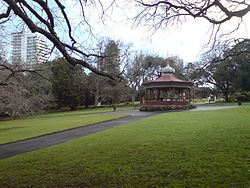Albert Park, Auckland
| Albert Park | |
|---|---|
 The band rotunda near the south end of the park | |
 | |
| Type | Urban park |
| Location | Auckland, New Zealand |
| Coordinates | 36°51′03″S 174°46′03″E / 36.8507°S 174.7675°E |
| Created | 1880s |
| Operated by | Auckland Council |
| Status | Open all year, 24 hours |
Albert Park is a public
History

While Albert Park is formed from sandstone, to the north-west of the park is the
Albert Park occupies much of the site of the Albert Barracks, one of Auckland's early European military fortifications. In the 1850s and 1860s, Albert Barracks to many soldiers including those of the 58th Regiment.[5] The barracks consisted of a number of wooden and masonry structures standing in an enclosed area surrounded by a rock fortification built of the local volcanic stone. A portion of this wall remains visible in the adjacent University of Auckland grounds, and is registered by Heritage New Zealand as a Category I historic place.[6]
The Park was set aside as a reserve in the 1870s, and developed as a park in the 1880s.
The park's layout and design have not greatly changed since 1882. Due to the park's proximity to the University of Auckland, it is a popular location for students to relax.[7]
Features

The design of the park was the result of a public competition and follows a formal layout with a main north-south axis. To the north of the axis is a bronze statue by
The
There are several other artworks and memorials in the park, including a marble
Near the flagpole and Boer War Memorial on the north side of the park are two large field guns that were once part of the defense system set up during the
Beneath the park are the extensive Albert Park tunnels. They were built in 1941 to be used as air raid shelters, but were decommissioned and sealed up before World War II ended. The tunnels were largely forgotten for many years and, although periodically over the last decades there are calls for them to be opened up, nothing has happened (probably purely for logistical reasons). There were large tunnel entrances at the top of Victoria Street, adjacent to the Art Gallery on Wellesley Street and from Constitution Hill. One can still be seen on Kitchener Street between Courthouse and Bacons Lane.
Notes
- ISBN 0-582-71784-1.
- ^ "Methodology and guidance for evaluating Auckland's historic heritage" (PDF). Auckland Council. August 2020. Retrieved 24 September 2021.
- ^ a b Walker, Celia (August 2020). "Albert Park". NZPlaces. Retrieved 24 September 2021.
- Ngāti Whātua-o-Ōrākei. Archived from the original(PDF) on 2 August 2021. Retrieved 24 September 2021.
- Auckland Museum. Archivedfrom the original on 2018-01-28. Retrieved 26 June 2021.
- ^ "Albert Barracks Wall". New Zealand Heritage List/Rārangi Kōrero. Heritage New Zealand. Retrieved 12 March 2016.
- ^ Wikidata Q116870435.
- ^ "Statue in the Albert Park fountain, Auckland Central, 2010".
- ^ "Queen Victoria Statue". Heritage New Zealand.
- ^ See the compilation of images by Jeff Pyle [1] Archived 2012-08-05 at the Wayback Machine
Gallery
-
View from Princes Street
-
View towards Wellesley Street
-
Floral clock
-
Sir George Grey statue
-
South-east view
-
North-west view
-
Auckland Lantern Festival 2009
-
Two phoenix palms frame a view of the Sky Tower
-
Albert Park in early summer
External links
- Albert Park, Auckland Council
- Plans of the tunnels, and a tale of exploration
- Auckland City's Management Plan for Albert Park
- Auckland Regional Council's Volcanic Hazards website
- Archaeopedia New Zealand
- Albert Park Fountain 3D
- Photographs of Albert Park held in Auckland Libraries' heritage collections









